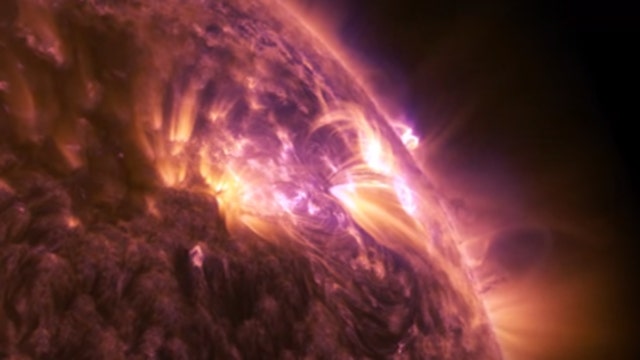On Thursday, the sun released a significant solar flare toward Earth, peaking at 11:35 a.m. EDT, scientists say.
Solar flares are powerful bursts of radiation and, although harmful radiation from flares cannot pass through the Earth's atmosphere to physically impact humans, when intense enough they can disturb the atmosphere in the layer where GPS and communications signals travel.
NASA SCIENTISTS CALL FOR NEW FRAMEWORK IN SEARCH FOR ALIEN LIFE
The flare was classified as an X1, with the X-class being the most intense. X10 flares are considered unusually intense.
This was the second X-class flare of Solar Cycle 25, which began in December 2019.
A video from NASA's Goddard Space Flight Center covering activity between Oct. 25-28 showed the flare.
Two other eruptions included an eruption of solar material called a coronal mass ejection and an invisible swarm of solar energetic particles that were flung toward Earth, Goddard said.
Coronal mass ejections are large clouds of solar plasma and embedded magnetic fields released into space after a solar eruption. NASA notes that the fastest Earth-directed coronal mass ejections can reach our planet in as little as 15-18 hours.
The particles hit the Earth's magnetic shield and can create a type of space weather known as a geomagnetic storm.
NASA, USPS TEAM UP TO CREATE STUNNING SUN STAMPS
"One of the most common forms of space weather, a geomagnetic storm refers to any time Earth's magnetic environment, the magnetosphere, undergoes sudden and repeated change," NASA Science explains. "Geomagnetic storms can be caused by high-speed blasts of the solar wind and when a CME connects up with the magnetosphere. The sun's magnetic fields peel back the outermost layers of Earth's fields changing the very shape of the magnetosphere. Magnetic storms have measurable effects worldwide, such as radio communication blackouts and power grid failures."
The National Oceanic and Atmospheric Administration Space Weather Prediction Center said Friday that a geomagnetic storm watch is in effect this weekend.
The center said impacts to technology from such a storm are generally nominal, but it has the potential to drive auroras further away from a normal polar residence.
Auroras are displays of light in the sky typically occurring the northern and southern regions that happen when incoming charged particles from the sun strike oxygen and nitrogen some 60 to 200 miles up in Earth's atmosphere, releasing a flash of light and heat.
CLICK HERE TO GET THE FOX NEWS APP
Electrons and protons released by solar storms can create bright auroras at lower latitudes.
Because of the latest flare, the Northern Lights may be visible over the far Northeast, upper Midwest and state of Washington – though it can be difficult to see it if you live near city lights.


